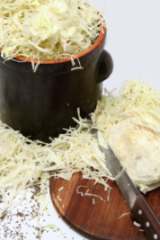Raw Recipe for Sauerkraut
The following is a guest post by Albert Hoak.
Raw recipe for sauerkraut uses lactic acid fermentation to make this raw treat.

Raw sauerkraut is a wonderful traditional food with many health benefits. Many of these benefits come from the process of fermenting the cabbage, increasing the level of healthful bacteria contained within the sauerkraut, aiding its digestibility and maximizing the amount of nutrients available when consumed. Many enzymes contained within raw sauerkraut are probiotic in nature and are considered anti-carcinogenic substances. Consuming raw sauerkraut promotes healthy intestinal flora and also strengthens a person’s overall digestive health. Commercially prepared sauerkraut lacks many of these beneficial properties due to the additional preparations necessary for wholesale distributing. The process of pasteurization kills most of the beneficial enzymes and nutrients found raw sauerkraut.
Fermentation of Sauerkraut
Sauerkraut is made by a process known as lactic acid fermentation. Lacto-fermentation is the natural culturing of various lactobacilli, a group of healthful bacteria. Anaerobic bacteria begins breaking down sugars present in the cabbage and this in turn produces lactic acid, altering the sauerkraut’s pH. The pH level in sauerkraut is so low that harmful bacteria cannot grow.
Botulism is not a concern with properly fermented sauerkraut due to the low pH achieved during the process. Also, raw sauerkraut can safely be stored for several months in a cool place, provided it is in an airtight container. It should not be pasteurized or heat-canned as those processes destroy the healthful bacteria.
Raw Sauerkraut Recipe
To make one quart or sauerkraut you will need:
1 medium-sized bowl
1 wide mouth mason jar with a lid
1 meat hammer
1 medium organic cabbage, cored and finely shredded
2 tablespoons of
sea salt
Directions:
To start, mix the finely shredded cabbage with the sea salt in a large bowl, then pound the mixture with the meat hammer or similar tool to release the water contained in the cabbage.
Place the entire contents of the bowl into a wide-mouth mason jar and press down on the cabbage until the juices are covering it and there is a minimum head space of 1 inch. Cover the jar tightly with the lid and store at room temperature for 3 to 4 days; check the progress of the sauerkraut’s fermentation every day or two. After this initial fermentation period it may be eaten or transferred to cold storage, an area that is near 40º F.
Raw sauerkraut’s flavor improves with age, the optimum flavor being reached near the sixth month.

Another Recipe for Sauerkraut
This recipe for sauerkraut will make a gallon. You will need:
1 large bowl
1 meat hammer
1 large crock or food-safe plastic container
1 plate that will fit inside the crock
1 heavy weight (5 to 10 pounds)
1 clean cloth
5 pounds of cabbage
3 tablespoons of sea salt
Directions:
To start, finely shred the cabbage. Mix the shredded cabbage with the sea salt in the large bowl. Begin placing the salted cabbage in the crock a little bit at a time, then pound each layer down with the meat hammer as you place it in the crock to begin releasing the juices. Add the plate to the top of the crock and then place the weight on top of the plate; this helps hold the shredded cabbage below the juices. Cover the crock with a clean cloth and let it sit at room temperature.
Press down on the weight occasionally to help release more juices. Check the fermentation’s progress every few days. If the juices are evaporating too rapidly, add salt water to the crock until the plate is covered.
After the initial fermentation is complete, you can remove some of the sauerkraut to a smaller jar kept in the refrigerator. Transfer the remaining sauerkraut in the crock to a cold storage location, making sure there is sufficient juice to cover the plate.
Sometimes
you may notice a slight film or mold on the surface of the sauerkraut;
skim off all that you can with a wooden spoon. It does not mean the
fermentation has failed, just that a bit was exposed to air.
Finished with Recipe for Sauerkraut?
Check out these other lactic acid fermentation topics:
Go from Recipe for Sauerkraut to HOME of Raw Food Diet Magazine
Follow
Guide with Over 50 Recipes!

Guide to Super Raw Foods is now available for Kindle or paperback on Amazon

Sign-up for Newsletter and get my Free E-Book Go Raw Not Crazy
Check Out These Sites:




